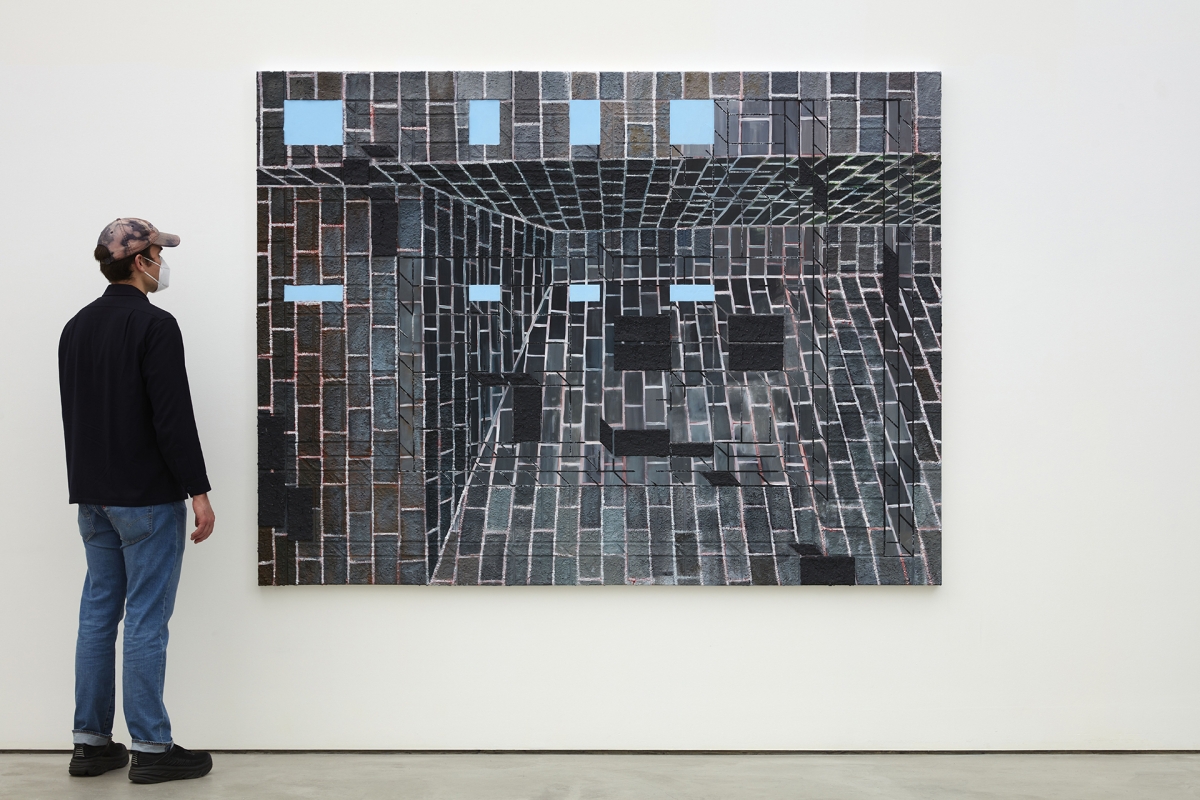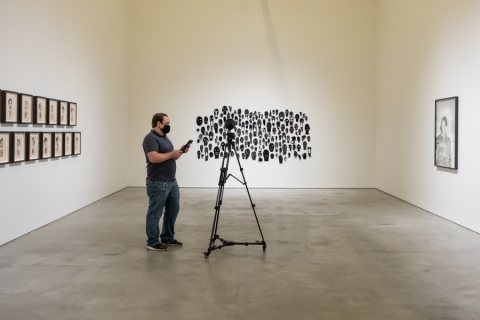Art in Absentia
UCI’s first professional exhibition in a virtual format, The Black Index, benefits from processes developed for student showcases during the pandemic
By Christine Byrd
When the artists, curators and preparators painstakingly install an exhibition in one of the Claire Trevor School of the Arts’ three galleries today, they know hardly anyone will set foot inside the space to see it.
Instead, a camera with six bug-eyed lenses will snap hundreds of circular photos, which will then be painstakingly stitched together into a virtual tour, and published online. So while the gallery sits empty, day in and day out, the hope is that more people than ever — and from farther corners of the world — will experience what’s inside it.
Welcome to the University Art Galleries (UAG) of the COVID-19 era.
Being Seen
The Black Index is debuting in the Contemporary Arts Center Gallery through March 20, curated by Bridget R. Cooks, UCI associate professor of African American studies and art history, and supported by a grant from the Ford Foundation. The exhibition features the work of six professional artists — Dennis Delgado, Alicia Henry, Kenyatta A.C. Hinkle, Titus Kaphar, Whitfield Lovell and Lava Thomas — who use drawing, performance, printmaking, sculpture and digital technology.
“The show’s artists are working on issues of Black self-representation,” says Kevin Appel, professor and chair of art. “The artworks often act as a source of self-expression that counters prevalent modes of representation of the Black body through photography.”
Cooks and Appel discussed bringing the show to UCI long before coronavirus became a household term, and decided to move forward with the show despite the restrictions on in-person viewers.
“One thing that was clear to me is Bridget’s desire not to delay the show, but to have it produced and seen, period,” says Appel. “So we have robust online programming that’s going to be well attended, and I’m hopeful that eventually more people will be able to see it in person when it goes on tour later this year.”
In addition to the digital viewing gallery and virtual tour, The Black Index at UAG features performances that will be posted online, as well as webinars with artists and scholars hosted alternately by UCI, The Getty, the Palo Alto Art Center and Hunter College.
“The Black Index is both timely and timeless,” says Allyson Unzicker, associate director of the UAG. “It is a critical and celebratory project that provides a space for Black representation and experience to thrive.”
Digital Developments
The UAG plays a critical role in sharing with the public what UCI students are doing, and what professional exhibitions the school supports.
“When everything shut down, we very quickly realized that we needed to have some way for that representation to continue,” says Appel. “Everyone in the art scene was scrambling to get their heads around how to move forward.”
Through both internal discussion and watching how museums, commercial galleries and smaller art spaces were responding, the UAG developed a new approach that relied more heavily on technology and online sharing.
One of the first places UAG and other art institutions turned was to social media. Unzicker says students in the undergraduate honors program had more eyes than ever on their artwork last spring, due to the galleries’ push to share both art and student interviews on Instagram — which has emerged as the favorite social platform for art.
“Instagram has had a big influence on fine art viewing,” says Jackson Hunt, M.F.A. ’20. “A lot of people see art online now, so there’s a consideration to make your work legible on Instagram and on phones. It’s a reality you can either embrace or push against.”
While many other universities continue with entirely virtual shows, the university decided to move forward with having M.F.A. students install their graduate exhibitions in the UAG, after several months of delay for safety. Students in their own cohort and faculty on their thesis committee were permitted inside the venue to view the thesis shows, but for everyone else, virtual tours were available online.
“Part of the learning process is that final realization of their work in a gallery,” says Unzicker.
As with all things during the pandemic, installing the art required adherence to additional safety protocols. Graduate students who would usually engage a group of fellow artists to help install their show, instead worked solo with the preparator — taking much longer than usual. Although this, too, has a silver lining.
“Because of social distancing, we didn’t have to share the gallery with someone else for our M.F.A. exhibition, so a lot of us really got to spread out and present something comparable to a big solo survey of work,” says Hunt, whose post-graduate M.F.A. thesis exhibition was in the Contemporary Arts Center Gallery (one of the UAG’s three venues) in fall of 2020.
While the space affected how much artwork Hunt showed, he says the pandemic also influenced his artwork in other ways. Once in lockdown, Hunt rethought the scale of his paintings, several of which he planned to be very large.
“It’s such a different viewing experience to stand in front of a painting where you’re really aware of the scale of the work in relation to your body, as opposed to mostly experiencing it online,” says Hunt. “I didn’t want to make a bunch of really large paintings that can’t be seen in person for the most part.”

Image: Jackson Hunt (M.F.A. Art ‘20) stands in front of his painting “Untitled” (2019) installed in his Post-graduate M.F.A. Thesis Exhibition, delayed for several months due to the pandemic. (Photo by Paul Salveson.)
Here to Stay
Hunt and his cohort were adapting to these changes on the fly last year. But Appel believes the coming months will bring about even more changes for artists at UCI and everywhere.
“One of the elements we can see shifting now is artists are thinking through methods of documentation as part of the creative process,” says Appel. “We’re seeing this start to trickle into the studio now. So, this is a learning opportunity for our students to begin to wrap their heads around this aspect of their work.”
More than a dozen exhibitions have now been produced by the UAG for primarily online viewing. The man behind the camera producing the 3D virtual tours is CTSA Technology Manager Bruce Warner. Unlike a realtor’s virtual tour, an art exhibition’s 3D tour must be carefully calibrated to avoid distorting the art, ensuring text is legible, and capturing the overall placement and scale of the work. Warner collaborates with the artists to ensure the final product reflects their vision for how the show should be viewed online.
“The students are super excited to have something that will live on,” says Warner. “It gives us a digital presence, so anyone in the world can view these tours and know that our students are doing amazing work here at UCI.”
These changes, both good and bad, do not appear to be going anywhere soon.
“Being in the space is a huge thing, but I will say that the increased focus on sharing art online is not going to go away,” says Appel. “Galleries will seize opportunities for less expensive ways to get works seen, in addition to the in-person shows that they already produce. Like it or not, it’s here to stay.”
See The Black Index and the M.F.A. thesis shows presented online at uag.arts.uci.edu. Learn more about the Department of Art at art.arts.uci.edu.
Please visit our secure direct giving page and make a gift to support to CTSA today!

